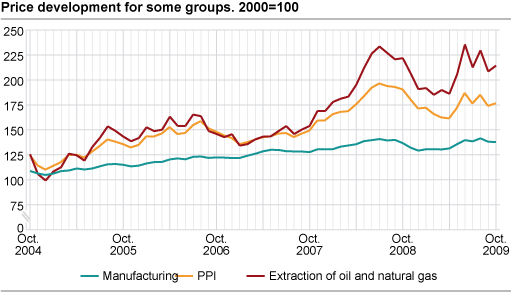Content
Published:
This is an archived release.
Price increases on energy goods
An increase in prices for oil, gas and electricity were the main reasons for the rise in the producer price index by 1.5 per cent from September to October. From last October to October this year, the producer price index fell by 4.1 percent.
The producer price index increased in total by 1.5 per cent from September to October. The price increase in extraction of oil and natural gas as well as increased electricity prices, is the main explanation for the overall price rise. For the industry, the prices went down in the same period.
Fall in export market prices
Prices within manufacturing, mining and quarrying dropped by 0.4 per cent from September to October, and the price decline is greater on the export market. There has been a fall in prices on investment, consumption and intermediate goods in this period.
Price decline on investment goods is derived mainly as a result of lower prices on goods within the machinery and equipment industry as well as computer and electrical equipment industry. The decline in prices for machinery and equipment industry was largely caused by falling prices of machinery and equipment for general use in the domestic market.
Prices of food products and textiles, wearing apparel and leather products, as well as furniture and manufacturing contributed to the decline in prices on consumer goods in October. The fall constitutes by respectively 0.6, 0.2 and 0.5 per cent for these industries and is larger in the export market.
Metal and paper and paper products accounted for much of the price decrease on intermediate goods in October, where they went down by 1.9 and 0.9 per cent respectively. This price decrease was somewhat tempered by higher prices within the chemical and pharmaceutical products, as well as wood and wood products industry.
Producer prices down by 4.1 per cent last twelve months
Producer prices went down by 4.1 per cent from October 2008 to October 2009. Lower prices of energy goods are the main reason for the decline in the total index with a 7 per cent fall in the period
For intermediate goods, prices fell by 2.6 per cent in the past twelve months. Oil refining, chemical and pharmaceutical industries as well as metals contributed most. Prices of energy goods had the largest decline in the domestic market, where prices decreased by 14.7 per cent in the period.
| October 2009 | Changes, per cent | ||||||||||||||||||||||||||||||||||||||
|---|---|---|---|---|---|---|---|---|---|---|---|---|---|---|---|---|---|---|---|---|---|---|---|---|---|---|---|---|---|---|---|---|---|---|---|---|---|---|---|
|
September 2009-
October 2009 |
October 2008-
October 2009 |
||||||||||||||||||||||||||||||||||||||
| Total index | 176.6 | 1.5 | -4.1 | ||||||||||||||||||||||||||||||||||||
| Extraction of oil and natural gas | 214.3 | 2.8 | -5.4 | ||||||||||||||||||||||||||||||||||||
| Manufacturing, mining and quarrying | 137.8 | -0.4 | 0.7 | ||||||||||||||||||||||||||||||||||||
| Electricity, gas and steam supply | 237.8 | 14.4 | -41.6 | ||||||||||||||||||||||||||||||||||||
| Main industrial groupings | |||||||||||||||||||||||||||||||||||||||
| Intermediate goods | 132.0 | -0.1 | -2.6 | ||||||||||||||||||||||||||||||||||||
| Investment goods | 124.6 | -1.4 | 3.6 | ||||||||||||||||||||||||||||||||||||
| Consumer goods | 122.7 | -0.6 | 2.8 | ||||||||||||||||||||||||||||||||||||
| Energy goods | 212.3 | 2.6 | -7.0 | ||||||||||||||||||||||||||||||||||||
For information on the commodity price index for the industrial sectors, see http://www.ssb.no/vppi_en
Additional information
Contact
-
Producer price index
E-mail: produsentpris@ssb.no
tel.: (+47) 21 09 40 00
-
Elisabeth Mælum
E-mail: elisabeth.maelum@ssb.no
tel.: (+47) 97 01 28 49
-
Morten Madshus
E-mail: morten.madshus@ssb.no
tel.: (+47) 40 90 26 94
-
Monika Græsli Engebretsen
E-mail: monika.graesli.engebretsen@ssb.no
tel.: (+47) 40 90 23 71
-
Håvard Georg Jensen
E-mail: havard.jensen@ssb.no
tel.: (+47) 40 90 26 86

